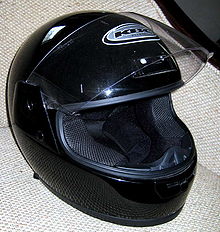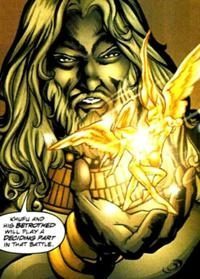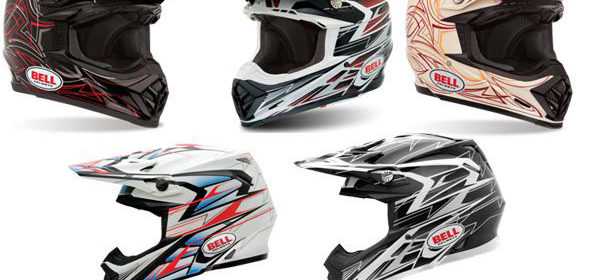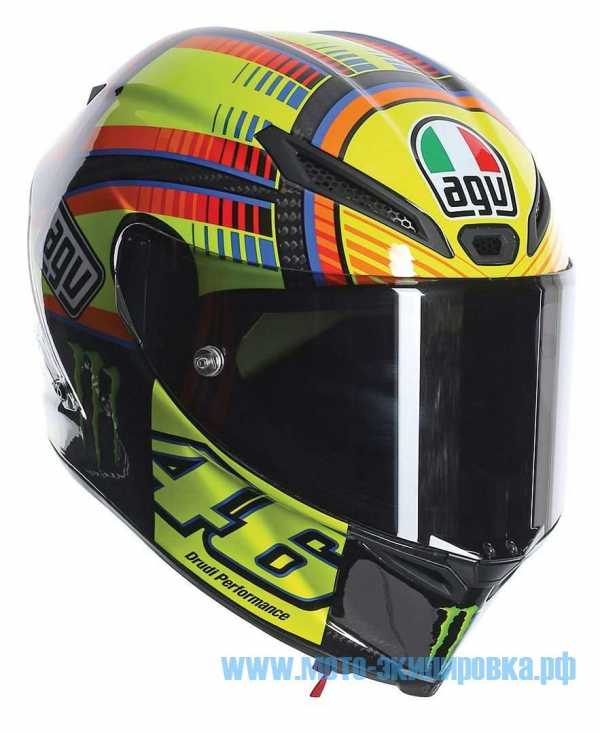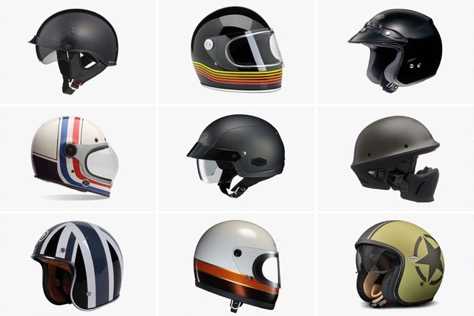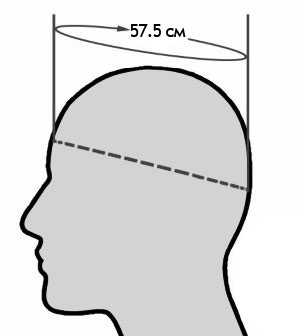Каска Броди. Шлем броди
Шлем Броди Википедия
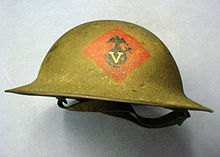 Каска Броди M1917. Каска 5-го полка корпуса морской пехоты США, времён Первой мировой войны, аналогичная британской
Каска Броди M1917. Каска 5-го полка корпуса морской пехоты США, времён Первой мировой войны, аналогичная британской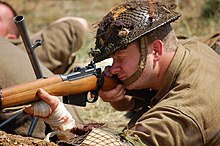
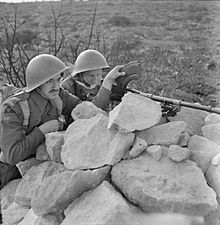
Каска Броди (англ. Brodie helmet) — британский стальной шлем, разработанный и запатентованный в 1915 году. Его создателем был лондонец Джон Леопольд Броди.
Создание шлема
В начале Первой мировой войны, когда военные действия перешли в позиционную стадию, оказалось, что существующие головные уборы, сделанные из кожи или ткани, не обеспечивают достаточной защиты солдат от осколков. После введения французами очень успешной каски Адриана англичане решили предоставить такую же каску для защиты своих солдат. Шлем (Helmet, steel, Mark I) был создан по образцу средневековой капеллины. Производство осуществляли из листового металла путём штамповки, таким образом, чтобы получить каску высокой прочности. Другим важным преимуществом каски несложной констукции являлась низкая стоимость производства.[1] Целью шлема была защита головы и плеч солдата от поражения свинцовыми фрагментами боеприпасов. Шлем такой формы мог хорошо выполнить эту задачу, если солдаты находились в окопах. После выхода из них он проявлял свой основной недостаток — шлем практически не защищал стороны головы. Шлем изначально был снабжён кожаным подтулейником и кожаным ремешком для подбородка. В 1936 году подтулейное устройство было заменено на новую, более удобную версию (версия Мк. 1 h3) .
Каски были изготовлены из листовой стали Гадфильда и приняты на вооружение британской армии в 1915 году, и американской армии в 1917 году под обозначением М1917, и широко применялись указанными сторонами в годы Первой мировой войны — общее количество шлемов этого типа превысило 7,5 млн экземпляров. Вес шлема (Mark I), по словам производителя, составлял примерно 1,2 фунта (0,5 кг) (по другим данным около двух фунтов). Толщина стали 0,9 мм.
В британской армии он был заменен на шлем Mk.II в 1939 году и шлем MK.III в 1943 году. В армии США шлем Броди с незначительными изменениями использовался до 1942 года, когда он был заменён шлемом M1.
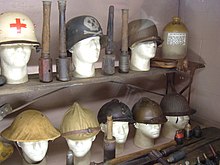 Каска Броди по сравнению с Германским штальхельмом и французской каской Адриана
Каска Броди по сравнению с Германским штальхельмом и французской каской Адриана Изображения
См. также
Примечания
wikiredia.ru
Шлем Броди Вики
 Каска Броди M1917. Каска 5-го полка корпуса морской пехоты США, времён Первой мировой войны, аналогичная британской
Каска Броди M1917. Каска 5-го полка корпуса морской пехоты США, времён Первой мировой войны, аналогичная британской

Каска Броди (англ. Brodie helmet) — британский стальной шлем, разработанный и запатентованный в 1915 году. Его создателем был лондонец Джон Леопольд Броди.
Создание шлема[ | код]
В начале Первой мировой войны, когда военные действия перешли в позиционную стадию, оказалось, что существующие головные уборы, сделанные из кожи или ткани, не обеспечивают достаточной защиты солдат от осколков. После введения французами очень успешной каски Адриана англичане решили предоставить такую же каску для защиты своих солдат. Шлем (Helmet, steel, Mark I) был создан по образцу средневековой капеллины. Производство осуществляли из листового металла путём штамповки, таким образом, чтобы получить каску высокой прочности. Другим важным преимуществом каски несложной констукции являлась низкая стоимость производства.[1] Целью шлема была защита головы и плеч солдата от поражения свинцовыми фрагментами боеприпасов. Шлем такой формы мог хорошо выполнить эту задачу, если солдаты находились в окопах. После выхода из них он проявлял свой основной недостаток — шлем практически не защищал стороны головы. Шлем изначально был снабжён кожаным подтулейником и кожаным ремешком для подбородка. В 1936 году подтулейное устройство было заменено на новую, более удобную версию (версия Мк. 1 h3) .
Каски были изготовлены из листовой стали Гадфильда и приняты на вооружение британской армии в 1915 году, и американской армии в 1917 году под обозначением М1917, и широко применялись указанными сторонами в годы Первой мировой войны — общее количество шлемов этого типа превысило 7,5 млн экземпляров. Вес шлема (Mark I), по словам производителя, составлял примерно 1,2 фунта (0,5 кг) (по другим данным около двух фунтов). Толщина стали 0,9 мм.
В британской армии он был заменен на шлем Mk.II в 1939 году и шлем MK.III в 1943 году. В армии США шлем Броди с незначительными изменениями использовался до 1942 года, когда он был заменён шлемом M1.
 Каска Броди по сравнению с Германским штальхельмом и французской каской Адриана
Каска Броди по сравнению с Германским штальхельмом и французской каской Адриана Изображения[ | код]
См. также[ | код]
Примечания[ | код]
ru.wikibedia.ru
Каска Броди - Википедия
Материал из Википедии — свободной энциклопедии
 Каска Броди M1917. Каска 5-го полка корпуса морской пехоты США, времён Первой мировой войны, аналогичная британской
Каска Броди M1917. Каска 5-го полка корпуса морской пехоты США, времён Первой мировой войны, аналогичная британской 

Каска Броди (англ. Brodie helmet) — британский стальной шлем, разработанный и запатентованный в 1915 году. Его создателем был лондонец Джон Леопольд Броди.
Создание шлема[ | ]
В начале Первой мировой войны, когда военные действия перешли в позиционную стадию, оказалось, что существующие головные уборы, сделанные из кожи или ткани, не обеспечивают достаточной защиты солдат от осколков. После введения французами очень успешной каски Адриана англичане решили предоставить такую же каску для защиты своих солдат. Шлем (Helmet, steel, Mark I) был создан по образцу средневековой капеллины. Производство осуществляли из листового металла путём экструзии, таким образом, чтобы получить каску высокой прочности. Другим важным преимуществом каски несложной констукции являлась низкая стоимость производства. Целью шлема была защита головы и плеч солдата от поражения свинцовыми фрагментами боеприпасов. Шлем такой формы мог хорошо выполнить эту задачу, если солдаты находились в окопах. После выхода из них он проявлял свой основной недостаток — шлем практически не защищал стороны головы. Шлем изначально был снабжён кожаным подтулейником и кожаным ремешком для подбородка. В 1936 году подтулейное устройство было заменено на новую, более удобную версию (версия Мк. 1 h3) .
Каски были изготовлены из листовой стали Гадфильда и приняты на вооружение британской армии в 1915 году, и американской армии в 1917 году под обозначением М1917, и широко применялись указанными сторонами в годы Первой мировой войны — общее количество шлемов этого типа превысило 7,5 млн экземпляров. Вес шлема (Mark I), по словам производителя, составлял примерно 1,2 фунта (0,5 кг) (по другим данным около двух фунтов). Толщина стали 0,9 мм.
В британской армии он был заменен на шлем Mk.II в 1939 году и шлем MK.III в 1943 году. В армии США шлем Броди с незначительными изменениями использовался до 1942 года, когда он был заменён шлемом M1.
 Каска Броди по сравнению с Германским штальхельмом и французской каской Адриана
Каска Броди по сравнению с Германским штальхельмом и французской каской Адриана Изображения[ | ]
encyclopaedia.bid
Каска Броди Википедия
 Каска Броди M1917. Каска 5-го полка корпуса морской пехоты США, времён Первой мировой войны, аналогичная британской
Каска Броди M1917. Каска 5-го полка корпуса морской пехоты США, времён Первой мировой войны, аналогичная британской

Каска Броди (англ. Brodie helmet) — британский стальной шлем, разработанный и запатентованный в 1915 году. Его создателем был лондонец Джон Леопольд Броди.
Создание шлема
В начале Первой мировой войны, когда военные действия перешли в позиционную стадию, оказалось, что существующие головные уборы, сделанные из кожи или ткани, не обеспечивают достаточной защиты солдат от осколков. После введения французами очень успешной каски Адриана англичане решили предоставить такую же каску для защиты своих солдат. Шлем (Helmet, steel, Mark I) был создан по образцу средневековой капеллины. Производство осуществляли из листового металла путём штамповки, таким образом, чтобы получить каску высокой прочности. Другим важным преимуществом каски несложной констукции являлась низкая стоимость производства.[1] Целью шлема была защита головы и плеч солдата от поражения свинцовыми фрагментами боеприпасов. Шлем такой формы мог хорошо выполнить эту задачу, если солдаты находились в окопах. После выхода из них он проявлял свой основной недостаток — шлем практически не защищал стороны головы. Шлем изначально был снабжён кожаным подтулейником и кожаным ремешком для подбородка. В 1936 году подтулейное устройство было заменено на новую, более удобную версию (версия Мк. 1 h3) .
Каски были изготовлены из листовой стали Гадфильда и приняты на вооружение британской армии в 1915 году, и американской армии в 1917 году под обозначением М1917, и широко применялись указанными сторонами в годы Первой мировой войны — общее количество шлемов этого типа превысило 7,5 млн экземпляров. Вес шлема (Mark I), по словам производителя, составлял примерно 1,2 фунта (0,5 кг) (по другим данным около двух фунтов). Толщина стали 0,9 мм.
В британской армии он был заменен на шлем Mk.II в 1939 году и шлем MK.III в 1943 году. В армии США шлем Броди с незначительными изменениями использовался до 1942 года, когда он был заменён шлемом M1.
 Каска Броди по сравнению с Германским штальхельмом и французской каской Адриана
Каска Броди по сравнению с Германским штальхельмом и французской каской Адриана Изображения
См. также
Примечания
wikiredia.ru
Каска Броди Вики
 Каска Броди M1917. Каска 5-го полка корпуса морской пехоты США, времён Первой мировой войны, аналогичная британской
Каска Броди M1917. Каска 5-го полка корпуса морской пехоты США, времён Первой мировой войны, аналогичная британской

Каска Броди (англ. Brodie helmet) — британский стальной шлем, разработанный и запатентованный в 1915 году. Его создателем был лондонец Джон Леопольд Броди.
Создание шлема[ | код]
В начале Первой мировой войны, когда военные действия перешли в позиционную стадию, оказалось, что существующие головные уборы, сделанные из кожи или ткани, не обеспечивают достаточной защиты солдат от осколков. После введения французами очень успешной каски Адриана англичане решили предоставить такую же каску для защиты своих солдат. Шлем (Helmet, steel, Mark I) был создан по образцу средневековой капеллины. Производство осуществляли из листового металла путём штамповки, таким образом, чтобы получить каску высокой прочности. Другим важным преимуществом каски несложной констукции являлась низкая стоимость производства.[1] Целью шлема была защита головы и плеч солдата от поражения свинцовыми фрагментами боеприпасов. Шлем такой формы мог хорошо выполнить эту задачу, если солдаты находились в окопах. После выхода из них он проявлял свой основной недостаток — шлем практически не защищал стороны головы. Шлем изначально был снабжён кожаным подтулейником и кожаным ремешком для подбородка. В 1936 году подтулейное устройство было заменено на новую, более удобную версию (версия Мк. 1 h3) .
Каски были изготовлены из листовой стали Гадфильда и приняты на вооружение британской армии в 1915 году, и американской армии в 1917 году под обозначением М1917, и широко применялись указанными сторонами в годы Первой мировой войны — общее количество шлемов этого типа превысило 7,5 млн экземпляров. Вес шлема (Mark I), по словам производителя, составлял примерно 1,2 фунта (0,5 кг) (по другим данным около двух фунтов). Толщина стали 0,9 мм.
В британской армии он был заменен на шлем Mk.II в 1939 году и шлем MK.III в 1943 году. В армии США шлем Броди с незначительными изменениями использовался до 1942 года, когда он был заменён шлемом M1.
 Каска Броди по сравнению с Германским штальхельмом и французской каской Адриана
Каска Броди по сравнению с Германским штальхельмом и французской каской Адриана Изображения[ | код]
См. также[ | код]
Примечания[ | код]
ru.wikibedia.ru
Каска Броди - WikiVisually
1. Каска – A helmet is a form of protective gear worn to protect the head from injuries. More specifically, a helmet aids the skull in protecting the human brain, ceremonial or symbolic helmets without protective function are sometimes used. The oldest known use of helmets was by Assyrian soldiers in 900 BC, soldiers still wear helmets, now often made from lightweight plastic materials. In civilian life, helmets are used for activities and sports, dangerous work activities. Since the 1990s, most helmets are made from resin or plastic, the word helmet is diminutive from helm, a medieval word for protective combat headgear. The Medieval great helm covers the head and often is accompanied with camail protecting throat. Originally a helmet was a helm which covered the head only partly, all helmets attempt to protect the users head by absorbing mechanical energy and protecting against penetration. Their structure and protective capacity are altered in high-energy impacts, beside their energy-absorption capability, their volume and weight are also important issues, since higher volume and weight increase the injury risk for the users head and neck. Anatomical helmets adapted to the head structure were invented by neurosurgeons at the end of the 20th century. Helmets used for different purposes have different designs, for example, a bicycle helmet must protect against blunt impact forces from the wearers head striking the road. A helmet designed for rock climbing must protect against heavy impact, sports helmets may have an integrated metal face protector. Baseball batting helmets have an expanded protection over the ear, which protects the jaw from injury, motorcycle helmets often have flip-down face screens for rain and wind protection, and they may also have projecting visors to protect the eyes from glare. Hard hats for construction workers are mainly to protect the wearer from falling objects such as tools. Helmets for riot police often have flip-down clear visors and thick padding to protect the back of the neck, Modern firefighters helmets protect the face and back of the head against impact, fires and electricity, and can include masks, communication systems, and other accessories. Welding helmets protect the eyes and face and neck from flash burn, ultraviolet light, sparks and heat. They have a window, called a lens shade, through which the welder looks at the weld. People with some medical conditions must wear a helmet to protect the brain, due to a gap in the braincase, mixed martial arts helmets have ear pads to prevent serious injuries to the athletes, who do not usually endure such force to the ears. Crash helmets for F1 racing drivers, their design and construction have evolved enormously, nevertheless, head and neck trauma remains the greatest single injury risk to drivers
2. Каска Адриана – The M15 Adrian helmet was a combat helmet issued to the French Army during World War I. Introduced in 1915, it was the first modern steel helmet, initially issued to infantry soldiers, in modified form they were also issued to cavalry and tank crews. The early stages of trench warfare proved that even basic protection of the head would result in a lower mortality rate among front-line soldiers. By the beginning of 1915 a rudimentary steel skull-cap was being issued to be worn under the kepi, consequently, the French staff ordered development of a metal helmet that could protect soldiers from the shrapnel of exploding artillery shells. Since soldiers in trenches were also vulnerable to shrapnel exploding above their heads, contrary to common misconception, the M15 helmet was not designed to protect the wearer from direct impact by rifle or machine gun bullets. The resulting headgear was credited to Intendant-General August-Louis Adrian, by the end of World War I, it had been issued to almost all infantry units fighting with the French Army. It was also used by some of the American divisions fighting in France, the French Gendarmerie mobile adopted a dark blue version in 1926, and continued to wear it into the 1960s, well after the regular army had discarded it. The helmet proved to be effective against shrapnel and it was cheap and easy to manufacture. S. S. R. and Yugoslavia. However, because the new steel helmets offered protection against actual bullets. It was also discovered that the placed on the front of helmets impaired the strength of the helmet because of the two slots required. This perceived weakness made several armies remove their national insignia altogether, early helmets were painted horizon-blue for French troops and khaki for colonial forces. Those made after 1935 are usually painted khaki, reflecting the French army movement to a more camouflaged uniform in the 1930s, the large ventilation hole under the comb, which had been a weak point of the old design, was also replaced with a series of small holes. The M26 helmet continued in use with the French Army until after World War II, during the interwar period Belgium began to produce their own domestically made M26 Adrians and exported them around the globe. These helmets can be distinguished from their French counterparts, because they have a slightly different comb, in other countries the Adrian-type helmets were also in use with the fire-fighting units, railway guards or marine infantry. Adrian helmets are still prized by collectors today, in December 1915, Winston Churchill, while serving as a major with the British Armys Grenadier Guards, was presented with an Adrian helmet by the French General Emile Fayolle. He is seen wearing it in photographs and in a portrait painted by Sir John Lavery
3. Капеллина – A kettle hat is a type of helmet made of steel in the shape of a brimmed hat. The only common element is a wide brim that afforded protection to the wearer. It gained its common English language name from its resemblance to a cooking pot. The kettle hat was common all over Medieval Europe and it was called Eisenhut in German and chapeau de fer in French. It was worn by troops of all types, but most commonly by infantry, however, those who did use it proved that it was something worthwhile. In many films, English men-at-arms and foot soldiers are seen wearing these helms. An extra benefit was that the rim protected from direct sunlight, the kettle hat would continue to be used by armies throughout Medieval Europe until the eventual adoption of helmets such as the cabasset, and morion during the Renaissance period. Hat-shaped helmets were not just a European invention, Japanese Ashigaru infantrymen wore the jingasa, a helmet shaped like the Japanese form of the conical Asian hat. When steel helmets reappeared in World War I, the kettle hat made its comeback as the British and U. S. Brodie helmet and these kettle helmets were also used in World War II by the British, Commonwealth forces. The British produced a helmet for use in World War II designed to give more protection to the head
4. Штамповка – Punching is a metal forming process that uses a punch press to force a tool, called a punch, through the workpiece to create a hole via shearing. The punch often passes through the work into a die, a scrap slug from the hole is deposited into the die in the process. Depending on the material being punched this slug may be recycled and reused or discarded, punching is often the cheapest method for creating holes in sheet metal in medium to high production volumes. When a specially shaped punch is used to create multiple usable parts from a sheet of material the process is known as blanking, in forging applications the work is often punched while hot, and this is called hot punching. Punch tooling is made of hardened steel or tungsten carbide. A die is located on the side of the workpiece and supports the material around the perimeter of the hole. There is an amount of clearance between the punch and the die to prevent the punch from sticking in the die and so less force is needed to make the hole. The amount of clearance needed depends on the thickness, with thicker materials requiring more clearance, the clearance is also dependent on the hardness of the workpiece. The punch press forces the punch through a workpiece, producing a hole that has an equivalent to the punch. All ductile materials stretch to some extent during punching which often causes the punch to stick in the workpiece. In this case, the punch must be pulled back out of the hole while the work is supported from the punch side. The hole walls will show burnished area, rollover, and die break, the slug from the hole falls through the die into some sort of container to either dispose of the slug or recycle it. Materials for the workpiece can vary, commonly being metals and plastics, the punch and die themselves can have a variety of shapes to create an array of different shaped holes in the workpiece. Multiple punches may be used together to create a part in one step, usually, the punch and die are close to the same dimensions, creating a sheared edge when they meet. Most punch presses are mechanically operated, but simple punches are often hand-powered, major components of this mechanical press are the frame, motor, ram, die posts, bolster, and bed. The punch is mounted into the ram, and the die is mounted to the bolster plate, the scrap material drops through as the workpiece is advanced for the next hole. A large computer-controlled punch press is called a CNC turret punch and it houses punches and their corresponding dies in a revolving indexed turret. These machines use hydraulic, pneumatic, or electrical power to press the shape with enough force to shear the metal, die and punch shapes affect the force during the punching process
5. Окоп – A defensive fighting position is a type of earthwork constructed in a military context, generally large enough to accommodate anything from one man to a small number of soldiers. The Tobruk name may have derived from its initial conception or idea by Rommel in the Siege of Tobruk, a foxhole is one type of defensive strategic position. It is a pit used for cover, usually for one or two men, and so constructed that the occupants can effectively fire from it. It is known more commonly within United States Army slang as a position or as a ranger grave. It is known as a hole in the United States Marine Corps, a Gun-Pit in Australian Army terminology. In British and Canadian military argot it equates to a range of terms including slit trench, or fire trench, during the American Civil War the term rifle pit was recognized by both U. S. Army and Confederate Army forces. During the fighting in North Africa Specifically in Tobruk - Libya and this was a very shallow excavation allowing one man to lie horizontally while shielding his body from nearby shell bursts and small arms fire. The slit trench soon proved inadequate in this role, as the few inches of dirt above the body could often be penetrated by bullets or shell fragments. It also exposed the user to assault by tanks, which could crush the man inside a shallow slit trench by driving into it. After the Battle of Kasserine Pass, U. S. troops increasingly adopted the modern foxhole, the foxhole widened near the bottom to allow a soldier to crouch down while under intense artillery fire or tank attack. Foxholes could be enlarged to two-soldier fighting positions, as well as excavated with firing steps for crew-served weapons or sumps for water drainage or live enemy grenade disposal. The Germans used hardened fortifications in North Africa and later in other fortifications, such as the Atlantic Wall, the Germans knew them officially as Ringstände, the Allies called them Tobruks because they had first encountered the structures during the fighting in Africa. Frequently, the Germans put a turret from an obsolete French or German tank on the foxhole and this gave the Tobruk enhanced firepower and the gunner protection from shrapnel and small arms. Modern militaries publish and distribute elaborate field manuals for the construction of DFPs in stages. Initially, a shell scrape is dug, much like a very shallow grave. Each stage develops the fighting position, gradually increasing its effectiveness, in this way, a soldier can improve the position over time, while being able to stop at any time and use the position in a fight. The fire step usually slopes down into a narrow slit called a grenade sump at the bottom to allow for live grenades to be kicked in to minimize damage from grenade fragments. When possible, DFPs are revetted with corrugated iron, star pickets, ideally, the revetting will also be dug in below ground level so as to minimise damage from fire and tank tracks
6. Сталь Гадфильда – Mangalloy, also called manganese steel or Hadfield steel, is a steel alloy containing an average of around 13% manganese. Mangalloy is known for its high strength and resistance to abrasion once in its work-hardened state. Mangalloy is made by alloying steel, containing 0.8 to 1. 25% carbon, mangalloy is a unique non-magnetic steel with extreme anti-wear properties. This allows mangalloy to retain its toughness, most steels contain 0.15 to 0. 8% manganese. High strength alloys often contain 1 to 1. 8% manganese, at about 1. 5% manganese content, the steel becomes brittle, and this trait increases until about 4 to 5% manganese content is reached. At this point, the steel will pulverize at the strike of a hammer, further increase in the manganese content will increase both hardness and ductility. At around 10% manganese content the steel will remain in its austenite form at room temperature if cooled correctly, both hardness and ductility reach their highest points around 12%, depending on other alloying agents. The primary of these agents is carbon, because the addition of manganese to low-carbon steel has little effect. The original Hadfield steel contained about 1. 0% carbon, mangalloy has fair yield strength but very high tensile strength, typically anywhere between 350 and 900 megapascals, which rises rapidly as it work hardens. Unlike other forms of steel, when stretched to the breaking point, instead, the metal necks and work hardens, increasing the tensile strength to very high levels, sometimes as high as 2000 MPa. This causes the adjacent material to neck down, harden, the typical elongation can be anywhere from 18 to 65%, depending on both the exact composition of the alloy and prior heat-treatments. It is also used in high impact environments like inside a shot peening machine and these alloys are finding new uses as cryogenic steels, due to their high strength at very low temperatures. Mangalloy is heat treatable, but the manganese lowers the temperature at which austenite transforms into ferrite, unlike carbon steel, mangalloy softens rather than hardens when rapidly cooled, restoring the ductility from a work-hardened state. Many of mangalloys uses are limited by its difficulty in machining. The metal cannot be softened by annealing and hardens rapidly under cutting and grinding tools, the material can be drilled with extreme difficulty using diamond or carbide. Although it can be forged from a heat, it may crumble if hammered when white-hot. It can be cut with a torch, but plasma or laser cutting is the preferred method. Despite its extreme hardness and tensile strength, the material may not always be rigid and it can be formed by cold rolling or cold bending
7. Первая мировая война – World War I, also known as the First World War, the Great War, or the War to End All Wars, was a global war originating in Europe that lasted from 28 July 1914 to 11 November 1918. More than 70 million military personnel, including 60 million Europeans, were mobilised in one of the largest wars in history and it was one of the deadliest conflicts in history, and paved the way for major political changes, including revolutions in many of the nations involved. The war drew in all the worlds great powers, assembled in two opposing alliances, the Allies versus the Central Powers of Germany and Austria-Hungary. These alliances were reorganised and expanded as more nations entered the war, Italy, Japan, the trigger for the war was the assassination of Archduke Franz Ferdinand of Austria, heir to the throne of Austria-Hungary, by Yugoslav nationalist Gavrilo Princip in Sarajevo on 28 June 1914. This set off a crisis when Austria-Hungary delivered an ultimatum to the Kingdom of Serbia. Within weeks, the powers were at war and the conflict soon spread around the world. On 25 July Russia began mobilisation and on 28 July, the Austro-Hungarians declared war on Serbia, Germany presented an ultimatum to Russia to demobilise, and when this was refused, declared war on Russia on 1 August. Germany then invaded neutral Belgium and Luxembourg before moving towards France, after the German march on Paris was halted, what became known as the Western Front settled into a battle of attrition, with a trench line that changed little until 1917. On the Eastern Front, the Russian army was successful against the Austro-Hungarians, in November 1914, the Ottoman Empire joined the Central Powers, opening fronts in the Caucasus, Mesopotamia and the Sinai. In 1915, Italy joined the Allies and Bulgaria joined the Central Powers, Romania joined the Allies in 1916, after a stunning German offensive along the Western Front in the spring of 1918, the Allies rallied and drove back the Germans in a series of successful offensives. By the end of the war or soon after, the German Empire, Russian Empire, Austro-Hungarian Empire, national borders were redrawn, with several independent nations restored or created, and Germanys colonies were parceled out among the victors. During the Paris Peace Conference of 1919, the Big Four imposed their terms in a series of treaties, the League of Nations was formed with the aim of preventing any repetition of such a conflict. This effort failed, and economic depression, renewed nationalism, weakened successor states, and feelings of humiliation eventually contributed to World War II. From the time of its start until the approach of World War II, at the time, it was also sometimes called the war to end war or the war to end all wars due to its then-unparalleled scale and devastation. In Canada, Macleans magazine in October 1914 wrote, Some wars name themselves, during the interwar period, the war was most often called the World War and the Great War in English-speaking countries. Will become the first world war in the sense of the word. These began in 1815, with the Holy Alliance between Prussia, Russia, and Austria, when Germany was united in 1871, Prussia became part of the new German nation. Soon after, in October 1873, German Chancellor Otto von Bismarck negotiated the League of the Three Emperors between the monarchs of Austria-Hungary, Russia and Germany
8. Штальхельм – Stahlhelm is German for steel helmet. The Imperial German Army began to replace the traditional boiled leather Pickelhaube with the Stahlhelm during World War I in 1916, the term Stahlhelm refers both to a generic steel helmet, and more specifically to the distinctive German design. The Stahlhelm, with its distinctive coal scuttle shape, was instantly recognizable and its name was also used by the Stahlhelm, a paramilitary nationalist organization established at the end of 1918. At the beginning of World War I, none of the combatants were issued with any form of protection for the other than cloth and leather caps. The French were the first to see a need for more protection—in late 1915 they began to issue Adrian helmets to their troops, the British and Commonwealth troops followed with the Brodie helmet and the Germans with the Stahlhelm. As the German army behaved hesitantly in the development of an effective head protection, stationed in the rocky area of the Vosges the Army Detachment Gaede recorded significantly more head injuries caused by stone and shell splinters than did troops in other sectors of the front. The artillery workshop of the Army Detachment developed a helmet that consisted of a cap with a steel plate. The plate protected not only the forehead but also the eyes, the design of the Stahlhelm was carried out by Dr. Friedrich Schwerd of the Technical Institute of Hanover. In early 1915, Schwerd had carried out a study of wounds suffered during trench warfare and submitted a recommendation for steel helmets. Schwerd then undertook the task of designing and producing a suitable helmet broadly based on the 15th century sallet, thirty thousand examples were ordered, but it was not approved for general issue until New Years 1916, hence it is most usually referred to as the Model 1916. In February 1916 it was distributed to troops at Verdun, following which the incidence of head injuries fell dramatically. The first German troops who had to use this helmet had been the stormtroopers of the Sturm-Bataillon Nr.5 which had been commanded by captain Willy Rohr, in contrast to the Hadfield steel used in the British Brodie helmet, the Germans used a harder martensitic silicon/nickel steel. As a result, and also due to the form, the Stahlhelm had to be formed in heated dies at a greater unit cost than the British helmet. The different Stahlhelm designs are named for their year of introduction, for example, the Modell 1942 which was introduced in 1942 is commonly known as M1942 or simply M42. Here, they are referred to by their M19XX names, the Stahlhelm was introduced into regular service during the Verdun campaign in early 1916. The shell came in different sizes, from 60 to 68, Helmet weight varied from 0.98 kg to 1.4 kg, depending on shell size. The suspension, or liner, consisted of a headband with three segmented leather pouches, each holding padding materials, and leather or fabric cords could be adjusted to provide a comfortable fit. The one-piece leather chin strap was attached to the shell by M1891 chinstrap lugs, suddenly, with a great clanging thud, I was hit on the forehead and knocked flying onto the floor of the trench
9. Торонто – Toronto is the most populous city in Canada and the provincial capital of Ontario. With a population of 2,731,571, it is the fourth most populous city in North America after Mexico City, New York City, and Los Angeles. A global city, Toronto is a centre of business, finance, arts, and culture. Aboriginal peoples have inhabited the area now known as Toronto for thousands of years, the city itself is situated on the southern terminus of an ancient Aboriginal trail leading north to Lake Simcoe, used by the Wyandot, Iroquois, and the Mississauga. Permanent European settlement began in the 1790s, after the broadly disputed Toronto Purchase of 1787, the British established the town of York, and later designated it as the capital of Upper Canada. During the War of 1812, the town was the site of the Battle of York, York was renamed and incorporated as the city of Toronto in 1834, and became the capital of the province of Ontario during the Canadian Confederation in 1867. The city proper has since expanded past its original borders through amalgamation with surrounding municipalities at various times in its history to its current area of 630.2 km2. While the majority of Torontonians speak English as their primary language, Toronto is a prominent centre for music, theatre, motion picture production, and television production, and is home to the headquarters of Canadas major national broadcast networks and media outlets. Toronto is known for its skyscrapers and high-rise buildings, in particular the tallest free-standing structure in the Western Hemisphere. The name Toronto is likely derived from the Iroquois word tkaronto and this refers to the northern end of what is now Lake Simcoe, where the Huron had planted tree saplings to corral fish. A portage route from Lake Ontario to Lake Huron running through this point, in the 1660s, the Iroquois established two villages within what is today Toronto, Ganatsekwyagon on the banks of the Rouge River and Teiaiagonon the banks of the Humber River. By 1701, the Mississauga had displaced the Iroquois, who abandoned the Toronto area at the end of the Beaver Wars, French traders founded Fort Rouillé on the current Exhibition grounds in 1750, but abandoned it in 1759. During the American Revolutionary War, the region saw an influx of British settlers as United Empire Loyalists fled for the British-controlled lands north of Lake Ontario, the new province of Upper Canada was in the process of creation and needed a capital. Dorchester intended the location to be named Toronto, in 1793, Governor John Graves Simcoe established the town of York on the Toronto Purchase lands, instead naming it after Prince Frederick, Duke of York and Albany. Simcoe decided to move the Upper Canada capital from Newark to York, the York garrison was constructed at the entrance of the towns natural harbour, sheltered by a long sandbar peninsula. The towns settlement formed at the end of the harbour behind the peninsula, near the present-day intersection of Parliament Street. In 1813, as part of the War of 1812, the Battle of York ended in the towns capture, the surrender of the town was negotiated by John Strachan. US soldiers destroyed much of the garrison and set fire to the parliament buildings during their five-day occupation, the sacking of York was a primary motivation for the Burning of Washington by British troops later in the war
10. Национально-революционная армия – It also became the regular army of the ROC during the KMTs period of party rule beginning in 1928. It was renamed the Republic of China Armed Forces after the 1947 Constitution, the NRA was founded by the KMT in 1925 as the military force destined to unite China in the Northern Expedition. Organized with the help of the Comintern and guided under the doctrine of the Three Principles of the People, other prominent commanders included Du Yuming and Chen Cheng. The end of the Northern Expedition in 1928 is often taken as the date when Chinas Warlord era ended, though smaller-scale warlord activity continued for years afterwards. In 1927, after the dissolution of the First United Front between the Nationalists and the Communists, the ruling KMT purged its leftist members and largely eliminated Soviet influence from its ranks. Chiang Kai-shek then turned to Germany, historically a great military power, the Weimar Republic sent advisors to China, but because of the restrictions imposed by the Treaty of Versailles they could not serve in military capacities. When Adolf Hitler became Chancellor in 1933 and disavowed the Treaty, the anti-communist Nazi Party, with Germany training Chinese troops and expanding Chinese infrastructure, while China opened its markets and natural resources to Germany. Max Bauer was the first advisor to China, the plan was never fully realised, as the eternally bickering warlords could not agree upon which divisions were to be merged and disbanded. Furthermore, since embezzlement and fraud were commonplace, especially in understrength divisions, therefore, by July 1937 only eight infantry divisions had completed reorganization and training. These were the 3rd, 6th, 9th, 14th, 36th, 87th, 88th, throughout the Chinese Civil War the National Revolutionary Army experienced major problems with desertion, with many soldiers switching sides to fight for the Communists. Troops in India and Burma during World War II included the Chinese Expeditionary Force, after the drafting and implementation of the Constitution of the Republic of China in 1947, the National Revolutionary Army was renamed as the Republic of China Armed Forces. At the apex of the NRA was the National Military Council, chaired by Chiang Kai-Shek, it directed the staffs and commands. However, many divisions were formed two or more other divisions, and were not active at the same time. Also, New Divisions were created to replace Standard Divisions lost early in the war and were issued the old divisions number, therefore, the number of divisions in active service at any given time is much smaller than this. The average NRA division had 5, 000–6,000 troops, an army division had 10, 000–15,000 troops. Not even the German-trained divisions were on par in terms of manpower with a German or Japanese division, the United States Armys campaign brochure on the China Defensive campaign of 1942–45 said, The NRA only had small number of armoured vehicles and mechanised troops. At the beginning of the war in 1937 the armour were organized in three Armoured Battalions, equipped with tanks and armoured cars from various countries, after these battalions were mostly destroyed in the Battle of Shanghai and Battle of Nanjing. The newly provided tanks, armoured cars, and trucks from the Soviet Union and Italy made it possible to create the only mechanized division in the army and this Division eventually ceased to be a mechanized unit after the June 1938 reorganization of Divisions
wikivisually.com





